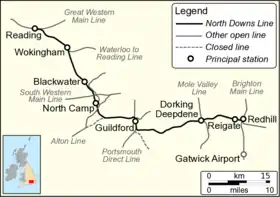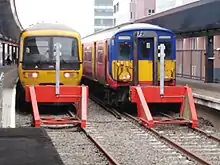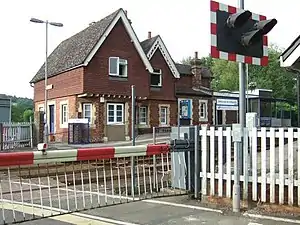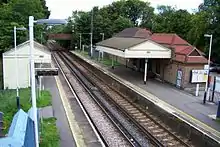North Downs Line
The North Downs Line is a passenger-train line connecting Reading to Redhill and Gatwick Airport, along the Brighton Main Line, linking many centres of population in that part of the North Downs which it traverses en route.
| North Downs Line | |
|---|---|
 North Downs Line | |
| Overview | |
| Status | Operational |
| Owner | Network Rail |
| Locale | Berkshire, Hampshire, Surrey |
| Termini | |
| Service | |
| Type | Suburban rail, Heavy rail |
| System | National Rail |
| Operator(s) | Great Western Railway Southern South Western Railway |
| Depot(s) | Reading TMD |
| Rolling stock | Class 165, Class 166, Class 450, Class 458, Class 377 |
| History | |
| Opened | 1849 |
| Technical | |
| Track gauge | 1,435 mm (4 ft 8+1⁄2 in) standard gauge |
| Electrification | 3rd rail, 750 V DC (Reading to Wokingham - Aldershot South Junction to Shalford Junction - Redhill to Reigate) |
| Operating speed | 70 mph (110 km/h) (maximum) |
North Downs Line | ||||||||||||||||||||||||||||||||||||||||||||||||||||||||||||||||||||||||||||||||||||||||||||||||||||||||||||||||||||||||||||||||||||||||||||||||||||||||||||||||||||||||||||||||||||||||||||||||||||||||||||||||||||||||||||||||||||||||||||||||||||||||||||||||||||||||||||||||||||||||||||||||||||||||||||||||||||||||||||||||||||||||||||||||||||||||||||||||||||||||||||||||||||||||||||||||||||||||||||||||||||||||||||||||||||||||||||||||||||
|---|---|---|---|---|---|---|---|---|---|---|---|---|---|---|---|---|---|---|---|---|---|---|---|---|---|---|---|---|---|---|---|---|---|---|---|---|---|---|---|---|---|---|---|---|---|---|---|---|---|---|---|---|---|---|---|---|---|---|---|---|---|---|---|---|---|---|---|---|---|---|---|---|---|---|---|---|---|---|---|---|---|---|---|---|---|---|---|---|---|---|---|---|---|---|---|---|---|---|---|---|---|---|---|---|---|---|---|---|---|---|---|---|---|---|---|---|---|---|---|---|---|---|---|---|---|---|---|---|---|---|---|---|---|---|---|---|---|---|---|---|---|---|---|---|---|---|---|---|---|---|---|---|---|---|---|---|---|---|---|---|---|---|---|---|---|---|---|---|---|---|---|---|---|---|---|---|---|---|---|---|---|---|---|---|---|---|---|---|---|---|---|---|---|---|---|---|---|---|---|---|---|---|---|---|---|---|---|---|---|---|---|---|---|---|---|---|---|---|---|---|---|---|---|---|---|---|---|---|---|---|---|---|---|---|---|---|---|---|---|---|---|---|---|---|---|---|---|---|---|---|---|---|---|---|---|---|---|---|---|---|---|---|---|---|---|---|---|---|---|---|---|---|---|---|---|---|---|---|---|---|---|---|---|---|---|---|---|---|---|---|---|---|---|---|---|---|---|---|---|---|---|---|---|---|---|---|---|---|---|---|---|---|---|---|---|---|---|---|---|---|---|---|---|---|---|---|---|---|---|---|---|---|---|---|---|---|---|---|---|---|---|---|---|---|---|---|---|---|---|---|---|---|---|---|---|---|---|---|---|---|---|---|---|---|---|---|---|---|---|---|---|---|---|---|---|---|---|---|---|---|---|---|---|---|---|---|---|---|---|---|---|---|---|---|---|---|---|---|---|---|---|---|---|---|---|---|---|---|---|---|---|---|---|---|---|---|---|---|---|---|---|---|---|---|---|---|---|---|---|---|---|---|---|---|---|---|
| ||||||||||||||||||||||||||||||||||||||||||||||||||||||||||||||||||||||||||||||||||||||||||||||||||||||||||||||||||||||||||||||||||||||||||||||||||||||||||||||||||||||||||||||||||||||||||||||||||||||||||||||||||||||||||||||||||||||||||||||||||||||||||||||||||||||||||||||||||||||||||||||||||||||||||||||||||||||||||||||||||||||||||||||||||||||||||||||||||||||||||||||||||||||||||||||||||||||||||||||||||||||||||||||||||||||||||||||||||||
The route
Between Redhill and Ash the line runs roughly parallel with the North Downs. Between Reigate and Gomshall the line runs along the foot of the North Downs escarpment in the Vale of Holmesdale. At Guildford it passes through the gap in the Downs formed by the River Wey, with two short tunnels just south of Guildford station, and further west between Guildford and Ash the line runs to the north of the Hog's Back. It then follows the Blackwater valley as far as Sandhurst, before continuing to Reading.
History of the line's construction
The line was authorised by Acts of Parliament in 1846 and 1847 and most of it was constructed by the Reading, Guildford and Reigate Railway Company (RG&RRC), opening in 1849. (A central section of the line near Guildford was built by a predecessor of the LSWR.) The stated objective of the company was to
- "secure through traffic passing between the West, North and Midlands and the Channel Ports avoiding the congestion of London and thus saving time, distance and expense."[1]
Although the company had some independent shareholders, it was closely associated with the South Eastern Railway (SER). The original intention was for the SER to build part of the line itself, but this proposal was rejected by Parliament. The independence of the company was only a formality to satisfy Parliament. The two companies had some common directors; an SER engineer controlled the construction of the line. As intended at outset, the line was leased to the SER in 1850, and the two companies finally merged in 1852. The company's relationship with the GWR is described as "enigmatic". The GWR initially offered the company the use of its facilities at Reading station, but terms could not be agreed and a separate station was built.[2]
The SER operated the line from its opening, and ran passenger services on it from Reading to London Charing Cross via Redhill. Even today, the distances along the line between Redhill (22 miles 40 chains) and Shalford Junction (41 mi 60 ch), and between Ash Junction (48 mi 34 ch) and Reading (68 mi 68 ch) are measured from the Charing Cross terminus of the former SER.[3]
Technical information
The line is two-track throughout and is designated W6 loading gauge. Overnight engineering possessions of up to 4+1⁄2 hours are available.[4]
- Reading station North Downs Line services normally terminate at platforms 4, 5 and 6 on the south side of Reading station, although access to other platforms is possible via Reading Spur Junction with the Great Western Main Line (see map, right). Trains may access the north side of Reading station via a single track underpass. Prior to the 2012 Reading resignalling scheme, trains served platforms 4a and 4b, on the site of the current 5 and 6, was via a short single track section, which severely limited capacity. As part of the resignalling scheme, an additional platform has been provided for North Downs Line services along with dual track access to the resulting three platforms. As a consequence platforms have been re-numbered as 4 (new), 5 (former 4b) and 6 (former 4a).[5]
- Reading to Wokingham is electrified (3rd rail, 750 V DC) and signalled under the track circuit block system from Wokingham Signal Box. Signalling headways are 3 minutes for fast services and 3+1⁄2 minutes for stopping services. The line speed is 70 mph (110 km/h), except for two 30 mph (48 km/h) restrictions (on the approach to Reading and through Wokingham station).
- Wokingham to North Camp is also under the control of Wokingham Signal Box, although long distances between signals increase headways to 6 minutes and 11 minutes for fast and stopping services respectively (the longest headways on the line). This section is not electrified and the line speed is 70 mph. It is currently planned to transfer the control of Wokingham Signal Box to the new Rail Operating Centre in Basingstoke in 2024.[6]
- North Camp to Shalford Junction is controlled from Guildford (TCB). Signalling headways are 2 minutes for fast services and 3 minutes for stopping services. This section is electrified (3rd rail, 750 V DC) from Aldershot South Junction. The line speed is 70 mph, except for a 40 mph (64 km/h) restriction at Ash Junction (between Ash and Wanborough) where the line curves sharply, and a 30 mph restriction on the approaches to Guildford station. Resignalling in October 1999 enabled reversible working on the down line through both tunnels between Guildford and Shalford Junction.[4]
- Shalford Junction to Reigate The route leaves the Portsmouth Direct Line at Shalford Junction and there is a 20 mph restriction. From here to Reigate, the line is not electrified. It is controlled by Guildford from Shalford Junction to Gomshall and by Reigate Signal Box (TCB) from Gomshall to Redhill.[7] Signalling headways are 5 minutes for fast trains and 7 minutes for stopping services. The line speed varies from 30 mph (on the approach to Shalford junction) to 70 mph.
- Reigate to Redhill is electrified (3rd rail, 750 V DC). The approach to Redhill is controlled by Three Bridges Signalling Centre and has a 30 mph speed restriction. Capacity restraints at Redhill were eased with the construction of a new platform and improvements to track work south of the station, as part of the Solum Regeneration project.[8] The new platform at Redhill opened in 2019 from which time additional services were planned to travel through to Gatwick Airport, where a new platform had been officially opened in February 2014.[9]
Network SouthEast originally planned to electrify the whole route, with a completion date of 1993 being published, but these plans were dropped.[10]
The major capacity constraints are the platform capacities of Reading, Redhill and Gatwick Airport stations.[11][12][13]
Current passenger services and rolling stock



The main services on the line are provided by Great Western Railway using Class 165 and Class 166 Network Turbo diesel multiple units. Hourly semi-fast services run from Reading to Gatwick Airport and there is a half-hourly stopping service between Reading and Redhill.[14][15] At Redhill the Gatwick Airport services reverse to head south along the Brighton Main Line.[11] Until 1994, the stopping services continued to Tonbridge, but the line between Redhill and Tonbridge was electrified in 1993. Trains on this section are now operated (by Southern) as a shuttle service between Redhill and Tonbridge only.[16]
Additional services on the North Downs Line are provided by South Western Railway between Reading and Wokingham (trains to/from London Waterloo) and between Ash and Guildford (trains to/from Alton or Ascot). Southern operates services between Reigate and Redhill and onwards to London.[16]
Southern operate frequent services using Class 377s electric multiple units between Reigate and London Victoria, utilising the North Downs Line between Reigate and Redhill stations where access can then be found onto the Brighton Mainline at Redhill.
In 2018, GWR announced that it would lease Class 769 hybrid multiple units for use on the North Downs Line and on other services in the Thames Valley.[17] In 2022, the company decided not to pursue plans to introduce the Class 769 fleet and stated that all units were to be returned to the lessor.[18]
Passenger services and rolling stock before privatisation

All of the stations between Shalford and Betchworth inclusive, were recommended for closure in the 1963 Reshaping of British Railways report.[19] The report recommended that the whole of the North Downs Line should be developed as a trunk route.[20]
Steam traction was replaced by 3R (Class 206) DEMUs on 4 January 1965. The new trains consisted of two 6S (class 201) coaches from the Hastings Line coupled to adapted 2EPB driving trailer units. As a result of the visible difference in width between the narrow Hastings Line stock and the standard width Hampshire trailer, the units were nicknamed Tadpoles.[21] Additional peak time services were hauled by Class 33 diesel locomotives until May 1977.[22]
The express service from Reading to Gatwick Airport was launched on 12 May 1980, using three-car Class 119 DMUs, based on the Western Region. The trains were especially modified for this service, to create extra luggage space: the buffet counter in the centre coach being removed.[23] Class 101 three-car units were later used on the route as well.[24]
Freight services
As of 2007 no scheduled freight services used the line.[11] The travelling post office train from Dover to Manchester Piccadilly via Tonbridge, Redhill, Guildford and Reading was routed along the line from May 1988[22] until 2004. The Network Rail 2008 Strategic Business Plan recommended that an enhancement project for the line should be pursued to enable freight traffic from the Channel Tunnel to use the line.[25]
Electrification proposals
Electrification had been shelved prior to World War II as it was felt that little traffic would be generated. Non-electrified parts of the North Downs Line included Wokingham to Ash (Aldershot South Junction) and Shalford Junction to Reigate. In August 1981 Modern Railways magazine studied an electrification strategy for the then Southern Region of British Railways. The article saw potential on the route with the area having developed rapidly, and also with the prospect of Channel Tunnel traffic; cross-country passenger and freight workings might also be diverted along the route. Subsequently, some of the routes considered were electrified, including Redhill – Tonbridge (1994). Until then, North Downs Line services continued from Redhill to Tonbridge.
According to internet sources, electrification of these sections of the North Downs Line was again discussed as part of the Blackwater Valley Rail Survey, in 1991. Motive power from the outset would have been the BR Mark I-based electric stock classes, but the idea was set aside, when the existing diesel multiple units on the region began to be replaced by the current Class 165/166 'Turbos'.
After the privatisation of British Rail, Railtrack electrified a siding on the line at Wokingham.
Electrification was proposed again in 2016 by Surrey County Council, based on research by four local enterprise partnerships. It was "suggested that the electrification would create around 8,000 jobs and stimulate £1.9 billion of economic growth".[26][27]
Lineside features

On the south side of the line between Chilworth and Gomshall, a box hedge topiary known as Jessie's Seat has been cut in the shape of a pheasant, perched on the back of a seat. It is a memorial to South Eastern Railway's guard Henry Wicks who was killed in an accident here in 1892.[28]
See also
References
- Jackson 1988, p. 7
- Course 1987, p. xxxviii
- Yonge, John (November 2008) [1994]. Jacobs, Gerald (ed.). Railway Track Diagrams 5: Southern & TfL (3rd ed.). Bradford on Avon: Trackmaps. maps 15A, 24B, 24A, 23, 24C, 25B, 27A. ISBN 978-0-9549866-4-3.
Miles from Charing Cross via Redhill
- "Business Plan 2006 - Route 3: South West Main Line" (PDF). Archived from the original (PDF) on 6 February 2012. Retrieved 17 November 2010.
- "Network Rail Business Plan" (PDF). 14 May 2007. Archived from the original (PDF) on 6 June 2011. Retrieved 17 November 2010.
- "Feltham and Wokingham re-signalling programme". Network Rail. 20 March 2023.
- "Reigate Signal Box's ten-year "MOT"". Network Rail. 28 January 2005. Retrieved 29 March 2023.
- "The Plan | Redhill | Solum Regeneration". Archived from the original on 7 September 2014. Retrieved 7 September 2014.
- "Gatwick Media Centre - News - Gatwick Airport rail station opens a new platform, signalling improved experience and reliability for passengers and commuters". Archived from the original on 7 September 2014. Retrieved 7 September 2014.
- Brown & Jackson 1990, p. 20.
- Network Rail: Reading to Gatwick Airport - Congested Infrastructure Capacity Analysis (2007) http://www.networkrail.co.uk/documents/4091_Reading%20to%20Gatwick%20Capacty%20Analysis.pdf%5B%5D
- "36470 RUS SWML 80pp.indd" (PDF). Archived (PDF) from the original on 9 November 2007. Retrieved 17 November 2010.
- "Network Rail Route Plan 2004 (Page 42) (9.4mb PDF)" (PDF). Archived (PDF) from the original on 27 October 2007. Retrieved 17 November 2010.
- "Three trains an hour on North Downs line". 14 September 2020. Archived from the original on 12 April 2021. Retrieved 12 April 2021.
- "GWR increases capacity to three trains an hour on North Downs line | RailStaff". Archived from the original on 12 April 2021. Retrieved 12 April 2021.
- "London and South East Rail Services" (PDF). www.nationalrail.co.uk. Archived from the original (PDF) on 29 September 2007.
- "GWR to lease Class 769 Flex 'trimode' trainsets". Railway Gazette. 20 April 2018. Retrieved 20 April 2018.
- "GWR fleet to shrink further as it abandons Class 769 introduction". Railway Gazette International. 23 December 2022. Retrieved 23 December 2022.
- Beeching, Richard (1963). The Reshaping of British Railways. London.
{{cite book}}: CS1 maint: location missing publisher (link) - Beeching, Richard (1965). Development of the major railway trunk routes. London.
{{cite book}}: CS1 maint: location missing publisher (link) - "3R (Class 206) "Tadpole" DEMUs". Semgonline.com. Archived from the original on 8 April 2008. Retrieved 17 November 2010.
- Jackson 1988, p. 25
- Brown & Jackson 1990, p. 58.
- Brown & Jackson 1990, p. 55.
- "Strategic Business Plan Update" (PDF). Archived from the original (PDF) on 7 June 2011. Retrieved 17 November 2010.
- "Electrifying North Downs Line will boost economy by almost £2 billion". 4 May 2016. Archived from the original on 4 May 2016. Retrieved 16 July 2017.
- "Bid to electrify 29-mile North Downs railway line". BBC News. July 2016. Archived from the original on 28 October 2016. Retrieved 22 June 2018.
- "People and the railway: Jessie's Seat". Network Rail. 28 February 2019. Archived from the original on 29 February 2020. Retrieved 28 February 2020.
Bibliography
- Brown, David; Jackson, Alan A. (1990). Network SouthEast Handbook. Harrow Weald: Capital Transport Publishing. ISBN 1-85414-129-5.
- Butt, R.V.J. (1995). The Directory of Railway Stations. Patrick Stephens Ltd. ISBN 1-85260-508-1.
- Course, Edwin, ed. (1987). Minutes of the Board of Directors of the Reading, Guildford and Reigate Railway Company. Guildford: Surrey Record Society. ISBN 978-0-90-297808-9.
- Jackson, A.A. (1988). Dorking's Railways. Dorking: Dorking Local History Group. ISBN 1-870912-01-2.

